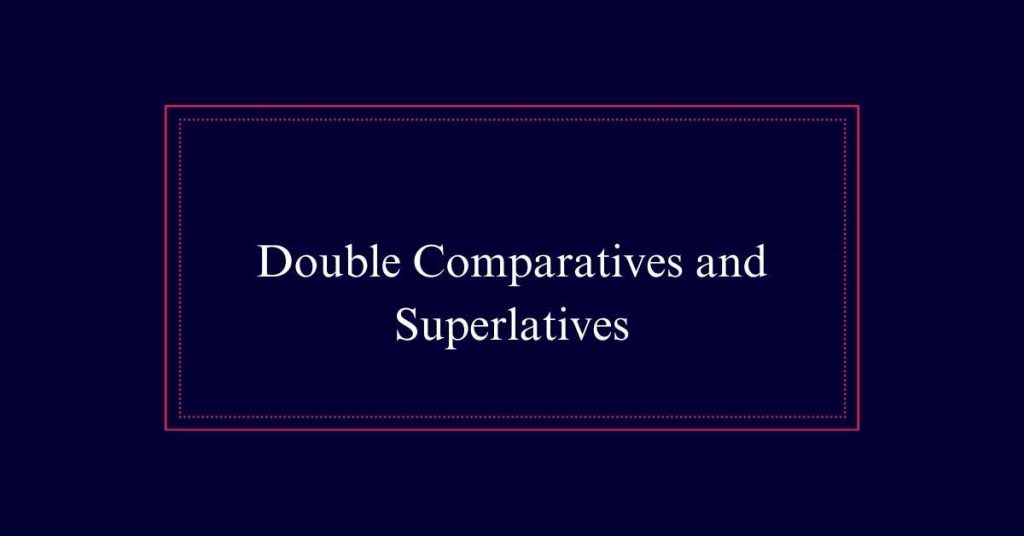Double Comparatives and Superlatives
Double comparatives incorrectly mix two forms, like using ‘more’ with an adjective ending in ‘-er’ (e.g., ‘more quicker’), leading to confusion. Stick to one form, either ‘-er’ or ‘more,’ for clarity. Superlatives show the highest or lowest degree and end in ‘-est’ or use ‘most’ (e.g., ‘fastest,’ ‘most interesting’). Always precede superlatives with ‘the’ for precision (e.g., ‘the fastest runner’).
Understanding Double Comparatives
Double comparatives occur when two things are compared using adjectives or adverbs, often resulting in common errors. In English, adjectives in the comparative form typically end in -er, such as ‘faster’ or ‘taller.’
Adverbs, particularly those ending in -ly, use ‘more’ for comparison, like ‘more quickly.’ A common mistake arises when writers combine both forms, resulting in awkward phrases. For instance, saying ‘more clearer’ instead of just ‘clearer.’
Common Double Comparative Errors
Recognizing and avoiding common double comparative errors is key to maintaining clarity in writing. One frequent mistake is using both ‘-er’ and ‘more’ together. For example, ‘She is more smarter than him’ should be corrected to ‘She is smarter than him.’
Another error is the combination of ‘more’ with an adjective that already uses ‘more’ for its comparative form, such as ‘more better.’ Instead, use ‘better.’ These errors can make sentences awkward and confusing. Writers should make certain that only one comparative form is used.
Correcting Double Comparative Mistakes
To correct double comparative mistakes, focus on using only one comparative form for each adjective or adverb. Begin by identifying the incorrect usage of both -er endings and the word more.
For example, instead of writing ‘She is more smarter,’ use ‘She is smarter.’ Similarly, avoid combining -ly adverbs with more, such as ‘more quicklyer.’ Opt for ‘more quickly’ instead.
Reviewing your sentences can help catch these errors. Read them aloud to make sure they sound natural. Simplifying your wording can prevent confusion.
Always choose either the -er form or the word more, but not both. This approach will make your writing clearer and more professional.

Superlative Degree Explained
The paramount degree is used to describe the highest or lowest degree of a quality among three or more things. It emphasizes the extreme or ultimate extent of a characteristic. For adjectives, the superlative form typically ends in -est, while adverbs often use the word most.
For example, ‘fastest’ and ‘most quickly’ are superlatives. Superlatives help to make clear, definitive comparisons. They are essential in highlighting the uniqueness of one item within a group. Proper usage guarantees precision and clarity in descriptions. Misuse, such as combining -est with most, can lead to awkward sentences.
The Role of ‘The’ in Superlatives
Using ‘the’ in superlative sentences is essential for proper grammar and clarity. The article ‘the’ identifies the noun being described as the highest in degree among a group.
For example, in ‘She is the smartest student in the class,’ ‘the’ specifies that the student stands out above all others. Without ‘the,’ the sentence loses its specificity and correctness.
Superlatives like ‘smartest,’ ‘largest,’ and ‘most beautiful’ need ‘the’ to clearly indicate that one item is being compared with many. This rule helps maintain clear communication and avoids ambiguity.
Comparing Mountains Correctly
Mastering the art of comparison in writing extends to accurately describing natural wonders, such as mountains. When comparing mountains, it is crucial to use proper comparative and superlative forms. For instance, Mount Everest is higher than K2, making Everest the highest mountain in the world. Avoid using double comparatives like ‘more higher’ or ‘most highest.’ Here is a comparison table for better clarity:
| Mountain | Height (m) | Comparative Form |
|---|---|---|
| Mount Everest | 8,848 | Higher |
| K2 | 8,611 | Higher than K2 |
| Kangchenjunga | 8,586 | Highest in the range |
| Lhotse | 8,516 | Higher than others |
Adjectives Vs. Adverbs in Comparison
In comparative writing, distinguishing between adjectives and adverbs is essential for clarity and effectiveness. Adjectives modify nouns or pronouns, while adverbs modify verbs, adjectives, or other adverbs.
When forming comparatives, adjectives typically end in -er (e.g., bigger), while adverbs often use more (e.g., more quickly). Misusing these forms can lead to confusion.
For instance, ‘She runs faster than him’ uses the adjective ‘faster’ correctly. Conversely, ‘She sings more beautifully’ uses the adverb ‘more beautifully’ properly.
Enhancing Descriptive Narratives
Adopting the correct use of adjectives and adverbs is key to enhancing descriptive narratives. These linguistic tools create vivid imagery and engage readers effectively.
Comparatives and superlatives, when used correctly, add depth to descriptions. They help in drawing clearer distinctions and highlighting extremes.
Here are three ways to enhance descriptive narratives:
- Precision: Use exact adjectives and adverbs to paint clear pictures. Instead of ‘very big,’ use ‘enormous.’
- Variety: Mix simple and complex descriptions for a balanced narrative. Avoid repetitive use of the same adjectives.
- Clarity: Confirm that comparatives and superlatives are correctly formed. This avoids confusion and maintains reader engagement.
Avoiding Common Comparative Mistakes
To avoid common comparative mistakes, make certain that adjectives and adverbs are used correctly in their comparative and superlative forms. For adjectives, use -er for comparatives and -est for superlatives. For adverbs ending in -ly, use more for comparatives and most for superlatives.
Avoid double comparatives like ‘more higher’ and double superlatives like ‘most fastest.’ Confirm that comparisons are complete and logical. For example, ‘John is taller’ should be ‘John is taller than Mike.’
Always use ‘the’ before superlatives, such as ‘the fastest.’ Reading sentences aloud can help catch mistakes. Clear and accurate use of comparatives and superlatives enhances your writing’s clarity and precision.






